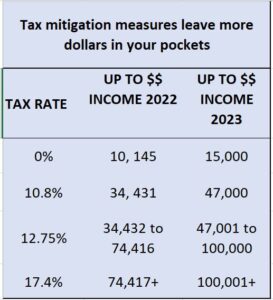The Premier’s priorities by Dorothy Dobbie
“Facing world challenges and having to apply local solutions,” was a trial in creating a budget for 2023, says Premier Heather Stefanson.
Issues such as the rising cost of living, residual shortages of labour in health care, mental health problems resulting from three years of fear and isolation, and a growing crime rate, put a lot of stress on our local economy and resources. “We had to find a balanced approach that would resolve outstanding personal care issues but that offered hope and resources to build our future on,” she said.
“We know we can’t solve health care overnight,” she says. “It’s a worldwide challenge, post-COVID, that everyone is struggling with, but we can apply immediate local fixes while we examine the lasting requirements that will rebuild our system.”
The current budget strives to do just that and while nothing is ever perfect, the thinking being applied to the issue is finally long-term and strategic. “And people are seeing the difference,” she says. “I have heard from many people who were very glad to be able to access relief for their medical conditions because of the special provisions we have added.”
She adds, “I know that it is not just about spending money either. We need to apply very practical answers to the problems encountered by the people, including front line workers, who are striving to accommodate the system when it should be the other way around.”
The premier is concerned about those who have a tough time making ends meet and many of the budget provisions address these issues. Increasing the amount of money an individual can earn before paying provincial taxes from $10,145 last year to $15,000 this year is one of those key issues. That means you have almost $5,000 more in your pockets before you pay provincial tax. This is of the most benefit to those living on a low income or a government pension and will save the average two-income family over $1,000 in taxes this year. Further help for low-income and average families was included by adjusting the income tax bracts.
The budget contained new measures to crack down on crime, on making neighborhoods safer, measures to assist those with addictions, measures to help abused women, especially Indigenous women, and more help for the mentally ill.
The carbon tax relief measure of $225 for singles and $375 for couples helps offset the high cost of fuel. As the finance minister Cliff Cullen pointed out, “By next year, we will have provided over $5,500 to help the average family make ends meet.”

It was a long budget speech with few stones left unturned to try and assist troubled services as well as individuals. There was help for education and municipalities, as well as for arts and culture
Supporting the possibilities for our future
At the same time, the Premier sees that her job is to present hope for the future. That is why, in addition to the bundle of social programs and support, a lot of the budget focus is on providing possibilities for Manitobans. If there are no well-paying jobs in the province, we will lose our children and our future, she says.
“We need to be economically competitive,” she points out, “in order to maintain good jobs for people. I want this for the Indigenous people in the North so that we can achieve economic reconciliation as well as for folks in the towns and cities down south,” she says.
“I want to work with industry to provide economic opportunity so that the good jobs come here and stay here instead of going to Alberta or Ontario or worse, south of the border.” According to projections, Manitoba will have at least 114,000 new job openings over the next five years and that means we need to invest in post-secondary education. More funding to these schools and holding the line on tuition fees are part of that.
Doubling the Venture Capital fund and lowering the threshold for the job-killing payroll tax instituted by the NDP so many years ago is a start. The Premier also recognizes that value of reopening Manitoba as a mining province by speeding up permitting and increasing the Manitoba Mineral Development Fund, among other measures.
But perhaps the most exciting initiative for most Manitobans is the refreshed investment in our transportation network, including the rebuilding of roads to international standards, enabling the growth and success of CentrePort and recognizing Manitoba’s critical location in the centre of the North American Continent with access to seaports. The premier has a bird’s eye view of the possibilities. She sees goods and products rolling from and through the province on wheels, on tracks, in the air and finally by sea. This means billions of dollars to our local economy, driving down taxes and increasing well-paying jobs.
There is more to come on this topic, she says. Stay tuned!

